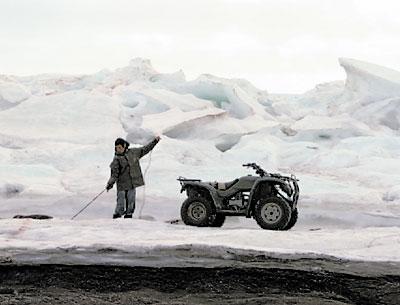GLOBAL WARMING: A Film and an Alaskan Island Race the Clock

From almost the moment that Gina Abatemarco conceived the idea six years ago for a film about a tiny island in Alaska that appears destined to be one of North America’s first victims of climate change, she has been raising money to bring that project to fruition.
Now, with some 500 hours of original footage, plus archival stills and home videos, she is in post-production on a feature-length documentary, “Kivalina People.”
She’s received funding from Vision Maker Media, formerly Native American Public Telecommunications, ensuring that the film will play on public television when it’s complete. She’s also gotten a New York University Richard Vague/Chris Columbus film production grant and support from the Tribeca Film Institute, the Independent Film Project, and the Puffin Foundation. Last month, she launched a $25,000 Kickstarter campaign online to raise the final money for post-production, the most expensive part of the filmmaking process. The campaign ends on April 25. If she does not meet her goal by then, the $11,000-plus in pledges she has received so far will be returned to backers.
It doesn’t mean the film won’t be made. Ms. Abatemarco and her crew, including Zoe White, the cinematographer, her editor, Melanie Vi Levy, and her co-producer, Ann Takahashi, have poured too much time and energy into the project to walk away. “The litmus test for how passionate you are about the work is that you keep coming back to it year after year,” Ms. Abatemarco said Friday.
Her parents have a house in Amagansett, and this winter she spent a month holed up with her editor at her parents’ place, poring over five years’ worth of footage from several trips to Kivalina Island, a 27-acre sliver of land 120 miles above the Arctic Circle on Alaska’s northwest coast.
Once protected from harsh winter seas by slush and sea ice that formed at its shores in the fall, Kivalina has become increasingly vulnerable as Arctic temperatures rise. Its native Inupiaq people, who were forcibly settled at the turn of the 20th century on an island that had previously served only as their summer hunting grounds, have asked the state and federal governments to support their relocation.
“Our goal is to respond and reflect on a moment in time in this community,” Ms. Abatemarco said. The film is a portrait “of a place that really could be gone” in a matter of years. It is about climate adaptation and “a community in transition trying to figure out what the future holds.”
“A film is a moment when art can meet activism,” said Ms. Abatemarco, who works as a film editor and is also writing a feature film about the life of the poet Lord Byron.
“You can have many, many conversations after this film . . . but ultimately it was meant to be a work of art. . . . The quality of the film is top of the line, and we did all of this paying ourselves really nothing.”
Since she began visiting the Arctic in 2008, Ms. Abatemarco has watched it change rapidly. The warming of the Arctic, she said, opens it up to oil exploration previously too difficult for large corporations to consider. And, “Since President Obama’s decision to lift the hold on Arctic ocean oil leases put into effect after the BP Deepwater Horizon tragic spill, there are more concerns for the people of Kivalina,” she wrote in a press packet on the film. Shell Oil began an Arctic development project last summer.
“These junky little towns now have a nice hotel and it’s hard to get a seat at the little diners,” she said of some of the nearby Alaskan villages. She feels an urgency to finish the film, not only because of how the changing climate is affecting the people of Kivalina and the very land they live on, but also because of this new interest in the Arctic.
A successful Kickstarter campaign will allow her to keep Ms. Vi Levy working full time on “Kivalina People,” with a goal of finishing by the summer. Those wishing to contribute to the project can find it at kickstarter.com.
“This needs to get out,” Ms. Abatemarco said, “and it needs to get out sooner rather than later.”
